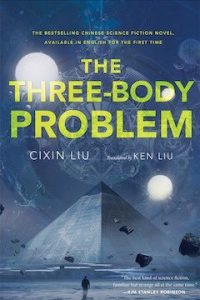[Editor’s Note: Mad Scientist Laboratory is pleased to present our November edition of “The Queue” – a monthly post listing the most compelling articles, books, podcasts, videos, and/or movies that the U.S. Army’s Training and Doctrine Command (TRADOC) Mad Scientist Initiative has come across during the previous month. In this anthology, we address how each of these works either informs or challenges our understanding of the Future Operational Environment (OE). We hope that you will add “The Queue” to your essential reading, listening, or watching each month!]
1. Is China a global leader in research and development? China Power Project, Center for Strategic and International Studies (CSIS), 2018.
The United States Army’s concept of Multi-Domain Operations 2028 describes Russia and China as strategic competitors working to synthesize emerging technologies, such as artificial intelligence, hypersonics, machine learning, nanotechnology, and robotics, with their analysis of military doctrine and operations. The Future OE’s Era of Contested Equality (i.e., 2035 through 2050) describes China’s ascent to a peer competitor and our primary pacing threat. The fuel for these innovations is research and development funding from the Chinese Government and businesses.
CSIS’s China Power Project recently published an assessment of the rise in China’s research and development funding. There are three key facts that demonstrate the remarkable increase in funding and planning that will continue to drive Chinese innovation. First, “China’s R&D expenditure witnessed an almost 30-fold increase from 1991 to 2015 – from $13 billion to $376 billion. Presently, China spends more on R&D than Japan, Germany, and South Korea combined, and only trails the United States in terms of gross expenditure. According to some estimates, China will overtake the US as the top R&D spender by 2020.”

Second, globally businesses are funding the majority of the research and development activities. China is now following this trend with its “businesses financing 74.7 percent ($282 billion) of the country’s gross expenditure on R&D in 2015.” Tracking the origin of this funding is difficult with the Chinese government also operating a number of State Owned Entities. This could prove to be a strength for the Chinese Army’s access to commercial innovation.

Third, the Chinese government is funding cutting edge technologies where they are seeking to be global leaders. “Expenditures by the Chinese government stood at 16.2 percent of total R&D usage in 2015. This ratio is similar to that of advanced economies, such as the United States (11.2 percent). Government-driven expenditure has contributed to the development of the China National Space Administration. The Tiangong-2 space station and the “Micius’ quantum satellite – the first of its kind – are just two such examples.”
2. Microsoft will give the U.S. military access to ‘all the technology we create’, by Samantha Masunaga, Los Angeles Times (on-line), 1 December 2018.
 Success in the future OE relies on many key assumptions. One such assumption is that the innovation cycle has flipped. Where the DoD used to drive technological innovation in this country, we now see private industry (namely Silicon Valley) as the driving force with the Army consuming products and transitioning technology for military use. If this system is to work, as the assumption implies, the Army must be able to work easily with the country’s leading technology companies. Microsoft’s President Brad Smith stated recently that his company will “provide the U.S. military with access to the best technology … all the technology we create. Full stop.”
Success in the future OE relies on many key assumptions. One such assumption is that the innovation cycle has flipped. Where the DoD used to drive technological innovation in this country, we now see private industry (namely Silicon Valley) as the driving force with the Army consuming products and transitioning technology for military use. If this system is to work, as the assumption implies, the Army must be able to work easily with the country’s leading technology companies. Microsoft’s President Brad Smith stated recently that his company will “provide the U.S. military with access to the best technology … all the technology we create. Full stop.”
This is significant to the DoD for two reasons: It gives the DoD, and thus the Army, access to one of the leading technology developers in the world (with cloud computing and AI solutions), and it highlights that the assumptions we operate under are never guaranteed. Most recently, Google made the decision not to renew its contract with the DoD to provide AI support to Project Maven – a decision motivated, in part, by employee backlash.
Our near-peer competitors do not appear to be experiencing similar tensions or friction between their respective governments and private industry. China’s President Xi is leveraging private sector advances for military applications via a “whole of nation” strategy, leading China’s Central Military-Civil Fusion Development Commission to address priorities including intelligent unmanned systems, biology and cross-disciplinary technologies, and quantum technologies. Russia seeks to generate innovation by harnessing its defense industries with the nation’s military, civilian, and academic expertise at their Era Military Innovation Technopark to concentrate on advances in “information and telecommunication systems, artificial intelligence, robotic complexes, supercomputers, technical vision and pattern recognition, information security, nanotechnology and nanomaterials, energy tech and technology life support cycle, as well as bioengineering, biosynthetic, and biosensor technologies.”
Microsoft openly declaring its willingness to work seamlessly with the DoD is a substantial step forward toward success in the new innovation cycle and success in the future OE.
3. The Truth About Killer Robots, directed by Maxim Pozdorovkin, Third Party Films, premiered on HBO on 26 November 2018.
This documentary film could have been a highly informative piece on the disruptive potential posed by robotics and autonomous systems in future warfare. While it presents a jumble of interesting anecdotes addressing the societal changes wrought by the increased prevalence of autonomous systems, it fails to deliver on its title. Indeed, robot lethality is only tangentially addressed in a few of the documentary’s storylines: the accidental death of a Volkswagen factory worker crushed by autonomous machinery; the first vehicular death of a driver engrossed by a Harry Potter movie while sitting behind the wheel of an autonomous-driving Tesla in Florida, and the use of a tele-operated device by the Dallas police to neutralize a mass shooter barricaded inside a building.

Given his choice of title, Mr. Pozdorovkin would have been better served in interviewing activists from the Campaign to Stop Killer Robots and participants at the Convention on Certain Conventional Weapons (CCW) who are negotiating in good faith to restrict the proliferation of lethal autonomy. A casual search of the Internet reveals a number of relevant video topics, ranging from the latest Russian advances in unmanned Ground Combat Vehicles (GCV) to a truly dystopian vision of swarming killer robots.
Instead, Mr. Pozdorovkin misleads his viewers by presenting a number creepy autonomy outliers (including a sad Chinese engineer who designed and then married his sexbot because of his inability to attract a living female mate given China’s disproportionately male population due to their former One-Child Policy); employing a sinister soundtrack and facial recognition special effects; and using a number of vapid androids (e.g., Japan’s Kodomoroid) to deliver contrived narration hyping a future where the distinction between humanity and machines is blurred. Where are Siskel and Ebert when you need ’em?
4. “Walmart will soon use hundreds of AI robot janitors to scrub the floors of U.S. stores,” by Tom Huddleston Jr., CNBC, 5 December 2018.
 The retail superpower Walmart is employing hundreds of robots in stores across the country, starting next month. These floor-scrubbing janitor robots will keep the stores’ floors immaculate using autonomous navigation that will be able to sense both people and obstacles.
The retail superpower Walmart is employing hundreds of robots in stores across the country, starting next month. These floor-scrubbing janitor robots will keep the stores’ floors immaculate using autonomous navigation that will be able to sense both people and obstacles.
The introduction of these autonomous cleaners will not be wholly disruptive to Walmart’s workforce operations, as they are only supplanting a task that is onerous for humans. But is this just the beginning? As humans’ comfort levels grow with the robots, will there then be an introduction of robot stocking, not unlike what is happening with Amazon? Will robots soon handle routine exchanges? And what of the displaced or under-employed workers resulting from this proliferation of autonomy, the widening economic gap between the haves and the have-nots, and the potential for social instability from neo-luddite movements in the Future OE? Additionally, as these robots become increasingly conspicuous throughout our everyday lives in retail, food service, and many other areas, nefarious actors could hijack them or subvert them for terroristic, criminal, or generally malevolent uses.
The introduction of floor-cleaning robots at Walmart has larger implications than one might think. Robots are being considered for all the dull, dirty, and dangerous tasks assigned to the Army and the larger Department of Defense. The autonomous technology behind robots in Walmart today could have implications for our Soldiers at their home stations or on the battlefield of the future, conducting refueling and resupply runs, battlefield recovery, medevac, and other logistical and sustainment tasks.
5. What our science fiction says about us, by Tom Cassauwers, BBC News, 3 December 2018.
“Right now the most interesting science fiction is produced in all sorts of non-traditional places,” says Anindita Banerjee, Associate Professor at Cornell University, whose research focuses on global sci-fi. Sci-Fi and story telling enable us to break through our contemporary, mainstream echo chamber of parochialism to depict future technological possibilities and imagined worlds, political situations, and conflict. Unsurprisingly, different visions of the future imagining alternative realities are being written around the world – in China,  Russia, and Africa. This rise of global science fiction challenges how we think about the evolution of the genre. Historically, our occidental bias led us to believe that sci-fi was spreading from Western centers out to the rest of the world, blinding us to the fact that other regions also have rich histories of sci-fi depicting future possibilities from their cultural perspectives. Chinese science fiction has boomed in recent years, with standout books like Cixin Liu’s The Three-Body Problem. Afrofuturism is also on the rise since the release of the blockbuster Black Panther.
Russia, and Africa. This rise of global science fiction challenges how we think about the evolution of the genre. Historically, our occidental bias led us to believe that sci-fi was spreading from Western centers out to the rest of the world, blinding us to the fact that other regions also have rich histories of sci-fi depicting future possibilities from their cultural perspectives. Chinese science fiction has boomed in recent years, with standout books like Cixin Liu’s The Three-Body Problem. Afrofuturism is also on the rise since the release of the blockbuster Black Panther.
The Mad Scientist Initiative uses Crowdsourcing and Story Telling as two innovative tools to help us envision future possibilities and inform the OE through 2050. Strategic lessons learned from looking at the Future OE show us that the world of tomorrow will be far more challenging and dynamic. In our FY17 Science Fiction Writing Contest, we asked our community of action to describe Warfare in 2030-2050. The stories submitted showed virtually every new technology is connected to and intersecting with other new technologies and advances. The future OE presents us with a combination of new technologies and societal changes that will intensify long-standing international rivalries, create new security dynamics, and foster instability as well as opportunities. Sci-fi transcends beyond a global reflection on resistance; non-Western science fiction also taps into a worldwide consciousness – helping it conquer audiences beyond their respective home markets.
6. NVIDIA Invents AI Interactive Graphics, Nvidia.com, 3 December 2018.
 A significant barrier to the modeling and simulation of dense urban environments has been the complexity of these areas in terms of building, vehicle, pedestrian, and foliage density. Megacities and their surrounding environments have such a massive concentration of entities that it has been a daunting task to re-create them digitally. Nvidia has recently developed a first-step solution to this ongoing problem. Using neural networks and generative models, the developers are able to train AI to create realistic urban environments based off of real-world video.
A significant barrier to the modeling and simulation of dense urban environments has been the complexity of these areas in terms of building, vehicle, pedestrian, and foliage density. Megacities and their surrounding environments have such a massive concentration of entities that it has been a daunting task to re-create them digitally. Nvidia has recently developed a first-step solution to this ongoing problem. Using neural networks and generative models, the developers are able to train AI to create realistic urban environments based off of real-world video.
As Nvidia admits, “One of the main obstacles developers face when creating virtual worlds, whether for game development, telepresence, or other applications is that creating the content is expensive. This method allows artists and developers to create at a much lower cost, by using AI that learns from the real world.” This process could significantly compress the development timeline, and while it wouldn’t address the other dimensions of urban operations — those entities that are underground or inside buildings (multi-floor and multi-room) — it would allow the Army to divert and focus more resources in those areas. The Chief of Staff of the Army has made readiness his #1 priority and stated, “In the future, I can say with very high degrees of confidence, the American Army is probably going to be fighting in urban areas,” and the Army “need[s] to man, organize, train and equip the force for operations in urban areas, highly dense urban areas.” 1 Nvidia’s solution could enable and empower the force to meet that goal.
If you read, watch, or listen to something this month that you think has the potential to inform or challenge our understanding of the Future OE, please forward it (along with a brief description of why its potential ramifications are noteworthy to the greater Mad Scientist Community of Action) to our attention at: usarmy.jble.tradoc.mbx.army-mad-scientist@mail.mil — we may select it for inclusion in our next edition of “The Queue”!
1 “Commentary: The missing link to preparing for military operations in megacities and dense urban areas,” by Claudia ElDib and John Spencer, Army Times, 20 July 2018, https://www.armytimes.com/opinion/commentary/2018/07/20/commentary-the-missing-link-to-preparing-for-military-operations-in-megacities-and-dense-urban-areas/.



